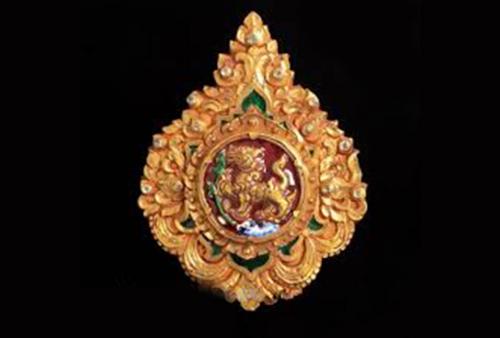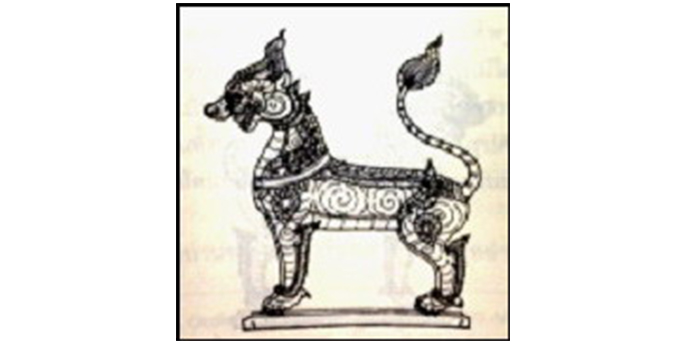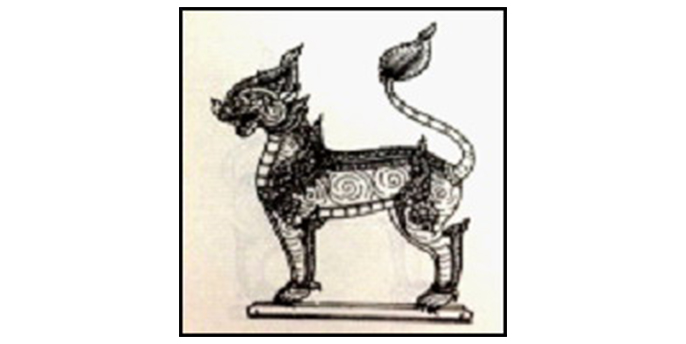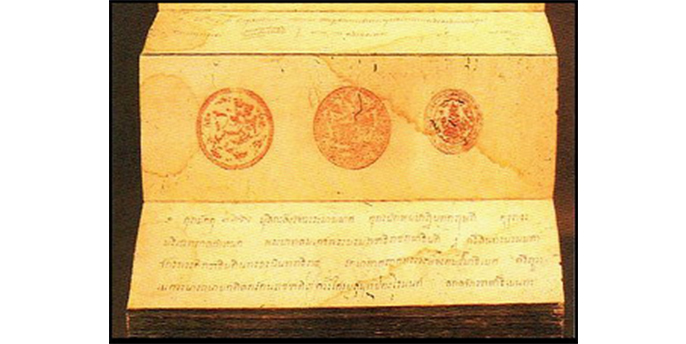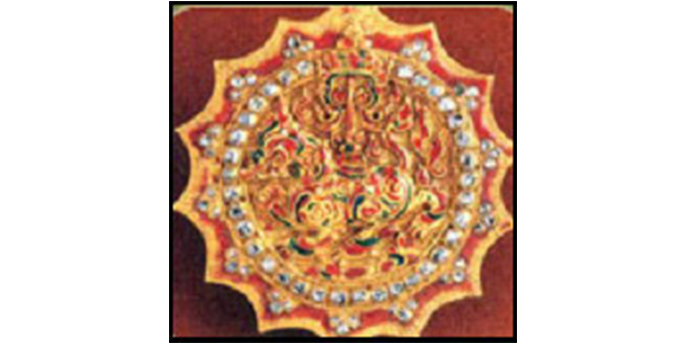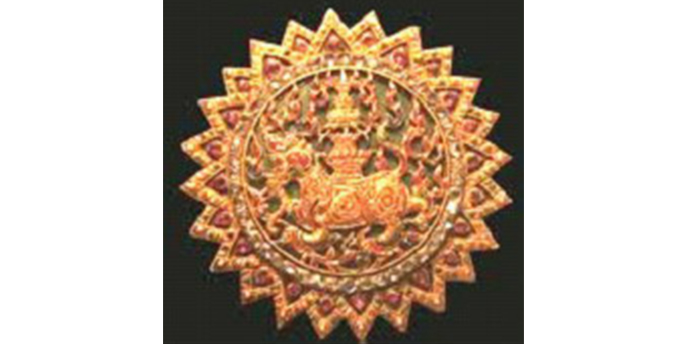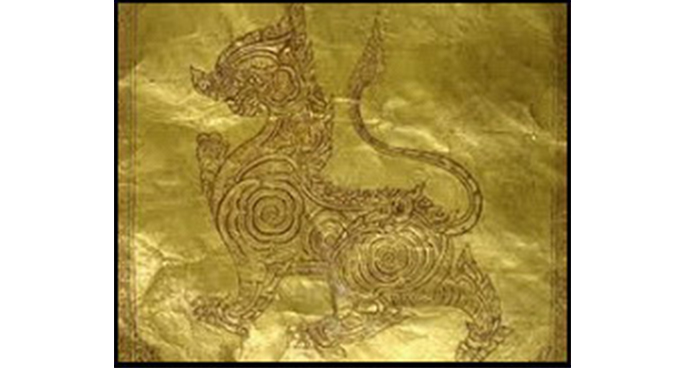"Rajasiha or Singha” is a savage mythological animal with the most power over others. It is an imaginary figure from a lion. According to individual fantasy of artists, the animal is depicted and seen in different extraordinary features. Since Rajasiha is related to grace and highness, it commonly appears as a symbol on significant seals.
Belief
In Brahman astrological manual, Rajasiha is the sun carrier. Shiva created the sun by grinding six Rajasihas thoroughly into powder, wrapped it with red cloth and sprinkled with Amarita immortal nectar. Rajasiha, therefore, means the sun to the Brahmans.
In Buddhism, Buddha was born a Rajasihaten times in former incarnations, as told in ten Jakata tales: Virojana-jakata, Sinkala-jakata, Sukorn-jakata, Kuna-jakata, Tatara-jakata, Sihagodhu-jakata, Manosh-jakata, Maha-ugus-jakata, Tuttupai-jakata and Sampook-jakata. Among thirty-two characteristics of a great man, Rajasiha is often mentioned as simile for perfect figure and appearance. Buddha was admiringly said to be a lion man because of his respectful manners.
Thrones in ancient time were sided with crouching lions, to manifest the throne power over the king of animals and all beings. The belief that the lion represents kingship was carried on to later time. Sculptures of crouching or sitting lions were made to stand beside the throne, known as the lion throne. Lion skin rugs were imported to pave over in front of the throne. The evolution of the lion throne leaves such decorations and only stands the throne on four lion feet.
Since Rajasiha is as well used to symbolize power, gratitude and protection, it is a popular building ornament which appears extensively on ancient fine-art pieces, as seen on stone carving icons or rock art in religious places. Prince Damrong Rajanubhab mentioned this in one part of his Myanmar travelogue, "…the entry of important jedis in Myanmar are sided with two Singhas. This seems unusual to me. China, Khmer and Java do the same. Singha is Rajasiha. In ancient time, Thailand also had Singhas stand at the entry. They are either of Khmer or Chinese style. The only place that Thai-styled Singha statue can be seen is Wat Phra Chetupon Temple. King Rama III ordered them to be made, possibly because the King never saw any in Thai style. To have Rajasiha at the entry may root from the belief of sacred statues as guardians”.
Types and Characteristics of Rajasiha
In literature, Rajasiha is king of the mythological Himmapan forest with power over all animals. There are four kinds of Rajasiha as follows;
Tinna Siha or Tinna Rajasri is said to have red body the size of a young bull and herbivorous in nature.

Tinna Siha
Kala Siha or Kala Rajasri is black and large as a young bull. It feeds on plants.
Kala Siha
Buntu Siha or Buntu Sura Mareu Kin is a carnivore with yellow body the size of a young bull.
Buntu Siha
Kraisorn Siha, Kesorn Siha or Kraisorn Siharaj is carnivorous and has red lips. Its red-white mane is seen from head to bottom. When coming out of the cave, it stands with parallel hind legs and elegantly stretches down the forelegs, sneezes loudly, shakes off all dirt, before running and roaring three times. The roaring sound goes so far that all wild animals can hear and have to escape with fear. Even tamed cows, buffaloes and horses all flee in panic. Because of its power over all animals, Kraisorn Siharaj is used as a seal symbol.
Kraisorn Siha
Below are seven qualities of Rajasiha;
Rajasiha is a purely clean animal.
Rajasiha walks fearlessly.
Rajasiha has large body with beautiful mane.
Rajasiha does not surrender, even when it is in life danger.
Rajasiha feeds unhurriedly and unfussy.
Rajasiha does not collect food.
Rajasiha does not struggle in hunting nor feeds more than need.
Rajasiha on a Seal
The use of Rajasiha to represent king power dates back to ancient times. The Thai royal court started the practice in the Ayutthaya period. According to Buddhist writings and many textbooks, Rajasiha is the powerful, dignified and respectable king of forest. It has the seven superb qualities and is believed to be the origin of the sun, the light of all mankind. These are all characteristics that a civil chief shall possess in performing loyal duty on behalf of the king and as a guardian of morals. Rajasiha, therefore, is chosen to be on the seal of the interior chief.
Prince Narisara Nuvadtivongs has made the presumption about the origin of the seal that, "the Phra Rajasiha seal seems to be made before the others. Since the warfare was the most important in the old time and so was the defense chief. The position is known as Senabodee in Thai, meaning the great among soldiers. As the kingdom expanded, two chiefs were in need for separate parts: armed force and civilians. The new seal was created having Kochasihaas symbol. Kochasri is a fearless-like- Rajasiha elephant.”
Kochasiha is a mixed lion with head features from an elephant (Kocha). Thais used elephants in war. The Kochasiha seal corresponds the duty of soldiers and was therefore chosen as the new seal of the defense chief.
The use of the seal of Phra Rajasiha
The use of the seal of Phra Rajasiha
From the Ayutthaya period to the early Rattanokosin Era, division chiefs received permission from the king for the use of seals. Only official documents from center to provinces were sealed. The seal of Phra Rajasiha impressed the Interior Division, of which the chief had command over civilians and soldiers in the northern part of Thailand. The seal of Phra Kochasiha authenticated documents fromthe Defense Division where the chief controlled the southern part. The seal of the Crystal Lotus of the Finance Division was used by Kosathibodi (Finance Chief), whose duty covered the royal expense, duty fee and foreign trade. The three seals played the supreme official role, as appearing on "the Law of Three Seals” in the reign of King Rama I. The chiefs had to return their seals after retirement.
There were two main types of the seal of Phra Rajasri: the great seal and the minor seal. The great seal of Phra Rajasiha represented the Royal command on "official documents” such as a letter to dependent countries or an official order to general provincial officers. The chief official affixed the seal of Phra Rajasiha over his signature. The great seal is kept in the King’s royal residence and not allowed to be carried around. The minor seal of Phra Rajasiha is affixed over the chief official’s name on all letters of order, commonly called "public notice”. More types of Phra Rajasiha seals also existed for other official purposes. The applied seal of Phra Rajasiha and the wax seal of Phra Rajasiha are good example. The minor seal was originally placed in the chief’s house. However, Prince Damrong Rajanubhab ordered the change of practice that an official servant stored the seal in the Luk Khun Hall in the Grand Palace where the Interior Ministry was located. This has ceased the tradition of keeping the seal at the chief’s residence.
The use of seals on letters of order without signature was effective until regulations were adjusted in the reign of King Rama V. Since then all public notice had to be signed. After the King had established the Ministry of Interior, all document needed to be signed and sealed. As the Siamese Revolution happened in 1932, official system was reorganized to suit the constitutional monarchy. A signature received a greater role than a seal. The Phra Rajasiha seal was no longer used to impress the rank of the chief, but to represent the Interior Ministry until today.
Rank marks in the Ratthakosin period
The First Rajasiha seal was made during the reign of King Rama IV
The reign of King Rama IV marked international relations and opened door to western civilization. Having witnessed that European kings attached rank marks to royal apparel, the King desired to create as such, yet inspired by Thai traditional sacred elements and patterns of existing seals. The first rank mark was established and granted to the Interior Chief, Chao Phraya Phutharaphai (Nut Bunyarattaphan). The pattern was adopted from Phra Rajasiha seal. The rank mark is in oval form surrounded by fourteen radiant gleams. It was made of enameled gold, having Rajasiha appear in the middle beneath a great crown, circle-lined with diamonds.
The Second Rajasiha seal was made during the reign of King Rama V
Later, King Rama V ordered the making of more rank marks and decorations with some adjustment to be traditional award to officers. The rank mark of the Interior Chief kept the same design. However, the great crown was replaced bya coronet and the gleams were changed to a blooming lotus.
Furthermore, on the necklace of the Special Class of the Most Illustrious Order of Chula Chom Klao is the Airavata (three-head elephant) sided with Rajasiha and Kotchasiha holding a tiered umbrella. The coronet on a tray appears above the back of the Airavata. The combination shows the contemporary concept of the use of Rajasiha and Kotchasiha as the symbol of rulers and kings.
Rajasiha and National Treasures
A gold plate with a depiction of Rajasiha
National treasures are utensils from Thai kings, royals, nobles and high-ranking officials. They as well include a gift for the person granted a higher status in previous times. The work of art created for each items is exquisite to glorify ranks and virtue.
Rajasiha, believed to be sacred and duly made relation to royals and eminent nobles since in the past, has been frequently used as a symbol on a variety of national treasures. It presented in auspicious royal ceremonies. For example, in royal coronation ritual during the Rattanakosin period, the king ascended the Bhaddharabith throne which was paved over by a gold plate with a depiction of Rajasiha in red color. This reflected the greatness of Rajasiha yet admitting defeat under the power of the throne. It also appeared on national treasures under the regalia category, which were given by the king as gifts to the other royals and nobles in the early Rattanakosin period. The example is an enameled gold betel nut casket decorated with the Rajasiha seal, corresponding to the rank mark of Phra Rajasiha.
In conclusion, Rajasiha is the influential mythological animal in Thai society. The character, grace, bravery and power, combined with primary religious belief, have brought Rajasiha to be the symbol on significant seals. Through the symbol, official chiefs and officers are advised to perform duty for the country under the royal power with honesty, brave and loyal.
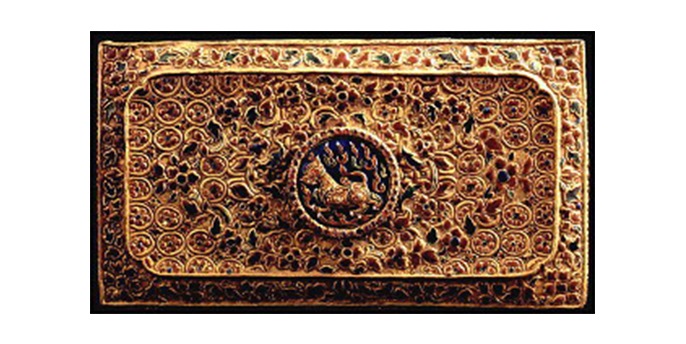
An enameled gold betel nut casket decorated with the Rajasiha seal
Translated from
Dawnapa Naowarangsee. (2014). Rajasiha: the seal symbol in the Rattanakosin period. (Thai version) Retrieved August 14,2014, from Pavilion of Regalia, Royal Decorations and Coins e-museum: http://emuseum.treasury.go.th
